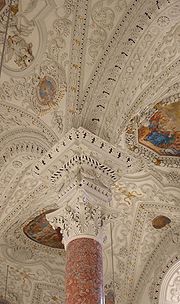
Wessobrunner School
Encyclopedia

Baroque sculpture
Baroque sculpture is the sculpture associated with the Baroque cultural movement, a movement often identified with the existence of important Baroque art and architecture in non-absolutist and Protestant states.-Course:...
stucco-workers that, beginning at the end of the 17th century, developed in the Benedictine Wessobrunn Abbey
Wessobrunn Abbey
Wessobrunn Abbey was a Benedictine monastery near Weilheim in Bavaria, Germany.It is celebrated as the home of the famous Wessobrunn Prayer and also of a Baroque school of stucco workers and plasterers in the 18th century....
in Bavaria
Bavaria
Bavaria, formally the Free State of Bavaria is a state of Germany, located in the southeast of Germany. With an area of , it is the largest state by area, forming almost 20% of the total land area of Germany...
, Germany
Germany
Germany , officially the Federal Republic of Germany , is a federal parliamentary republic in Europe. The country consists of 16 states while the capital and largest city is Berlin. Germany covers an area of 357,021 km2 and has a largely temperate seasonal climate...
.
The names of more than 600 stucco-workers who emerged from this school are known. The Wessobrunner stucco-workers exerted a decisive influence on, and at times even dominated, the art of stucco in south Germany in the 18th century.
The concept of the Wessobrunner School goes back to the art historians Gustav von Bezold and Georg Hacker, who in 1888 first used the name to designate this group of artists and craftsmen.
Members
The most important members were the brothers Johann Baptist ZimmermannJohann Baptist Zimmermann
Johann Baptist Zimmermann was a German painter and a prime stucco plasterer during the Baroque.Zimmermann was born in Gaispoint, Wessobrunn. He and his brother Dominikus Zimmermann were descended from an artist family of the Wessobrunner School...
and Dominikus Zimmermann
Dominikus Zimmermann
Dominikus Zimmermann was a German Rococo architect and stuccoist.-Life:Dominikus Zimmermann was born in Gaispoint near Wessobrunn in 1685 and became a Baumeister and a stuccoist. His older brother Johann Baptist Zimmermann was an architect and a frescoist...
, and the Schmuzer and Feichtmayer/Feuchtmayer
Feuchtmayer
The Feuchtmayers were a German family of artists from the Baroque Wessobrunner School....
families, both of whom were active over multiple generations. Certain members also worked as architects, including Johann and Joseph Schmuzer and Dominikus Zimmermann. Other important family names include Finsterwalder, Gigl, Merck, Rauch, Schaidauf, Übelher, and Zöpf.
Development of stucco-work
The technique of stucco-work was already in use around 7,000 BCE, and flourished during the Italian Renaissance. In Germany it appeared for the first time around 1545 CE in the Residenz at LandshutLandshut
Landshut is a city in Bavaria in the south-east of Germany, belonging to both Eastern and Southern Bavaria. Situated on the banks of the River Isar, Landshut is the capital of Lower Bavaria, one of the seven administrative regions of the Free State of Bavaria. It is also the seat of the...
. A passage in the "Historico-Topographica Descriptio" of Michael Wenig (1701) suggests that the residents of the villages Gaispoint and Haid, which belonged to Wessobrunn Abbey, worked predominantly as stucco-workers and bricklayers, which would imply a tradition of long standing.
In Bavaria an alliance between native bricklayers and stonemasons and Italian stucco-workers developed at the end of the 16th century. In the 17th century Wessobrunn developed into the most important center for stucco-work in Europe, and its craftsmen received commissions, not only in south Germany, but also in France, Poland, Hungary, and Russia. Their Italian competitors were unable to keep up.
Around 1750, a general decrease in building activity set in, as most of the great Rococo and pilgrimage churches had been completed. In addition, a new wave of neo-classical architecture between 1775 and 1790 lessened the prestige of the stucco-artist. The "Society of Stucco-workers", founded in 1783, still had 68 members; in 1798 there were 27, and by 1864 only 9.
The masterpiece of the Wessobrunner School is the pilgrimage church in Wies (from 1744), built and stuccoed by Dominikus Zimmermann and frescoed by his brother, Johann Baptist. In this building, even architectural elements become, as it were, ornament. The arches of the choir arcade are in fact monumental bisected rocaille-cartouches. To be sure, only Dominikus Zimmermann made the leap to this uncompromising architectural application of the rocaille.
As Bavarian artists began to stray from sculptural stucco and the taste of the time demanded more sobriety and functionality, the Wessobrunner School gradually lost its reason for being.
The reach of the Wessobrunner stucco-workers may today be observed in numerous European countries, and above all in western Austria.

